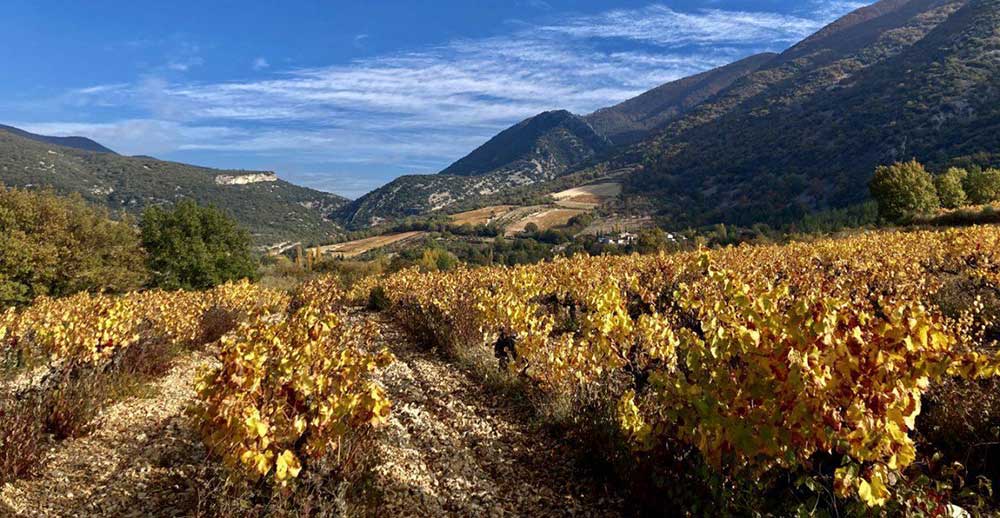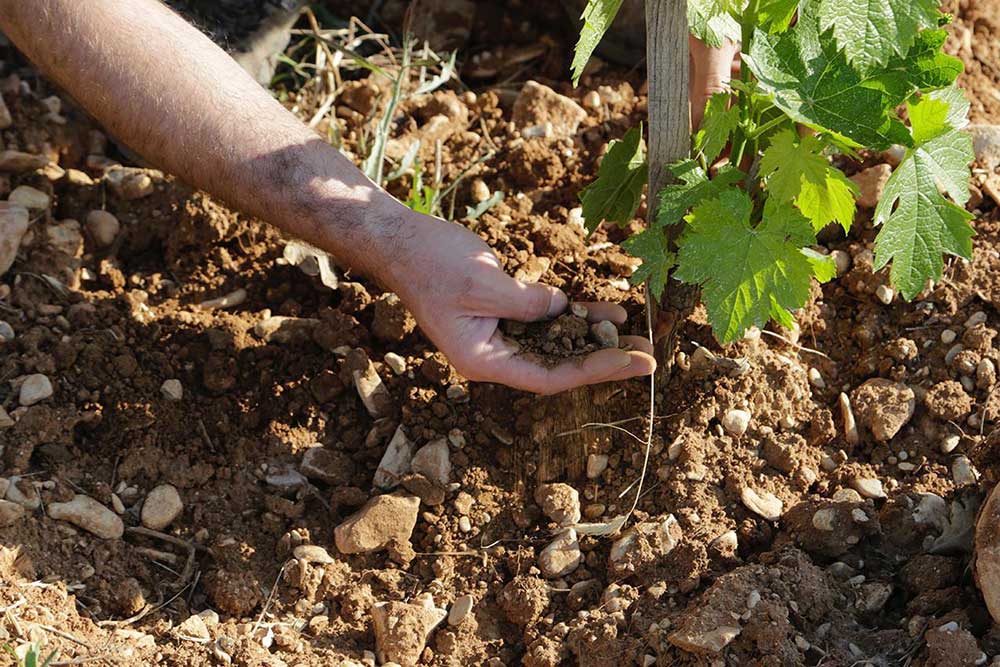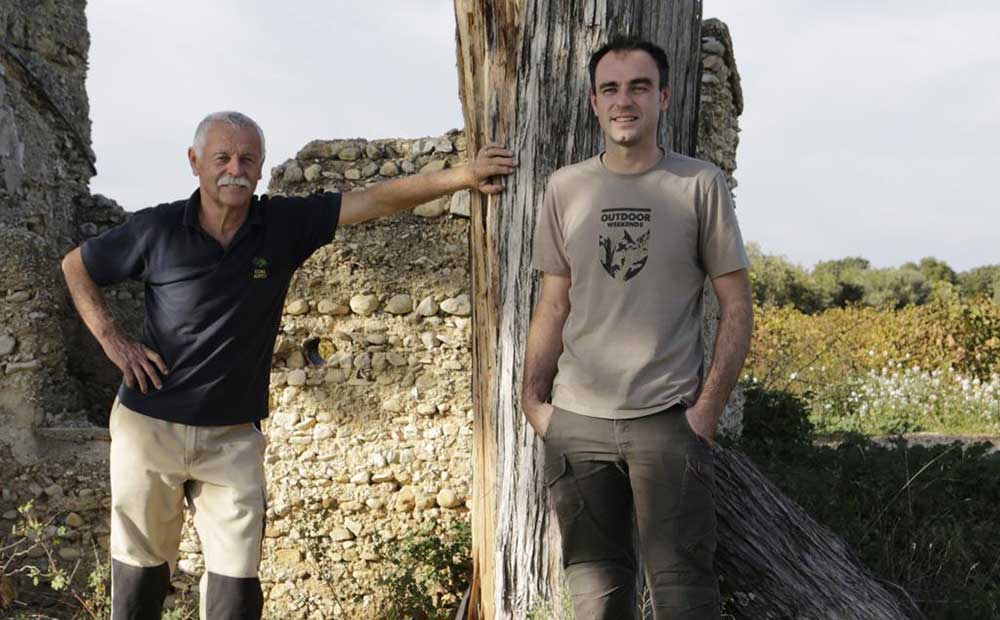Worldwide demand for the gloriously rich and generous wines of the Southern Rhône’s largest and most famous appellation, Châteauneuf-du-Pape (CNDP), has pushed prices beyond the reach of most. It’s also focused attention on the more affordable wines of nearby Gigondas, an appellation traditionally in the shadow of CNDP, more recently appreciated by astute drinkers for the value it offers. As a respected colleague said to me “We need to bang the drum for Gigondas a lot louder – crazy good wines at half the price (or less) of CNDP.”
 St Damien vineyards.
St Damien vineyards.
The countryside around the tiny village of Gigondas has been noted for its wine since Roman times, but when official appellation rules were introduced in France in the 1930s, the area was rather surprisingly relegated to the generic Côtes du Rhône status. It took until 1966 for it to be elevated to ‘Côtes du Rhône-Villages’ and in 1971 it was finally recognised with its own appellation. July and August of this year saw a series of celebrations in the appellation for its 50th anniversary, postponed from last year due to Covid.
The appellation sits within the Vaucluse département, a mere 10 miles northeast of CNDP, and with approximately 1,200ha of vines, is only about a third of the size. The often-terraced vineyards are protected by the imposing Dentelles de Montmirail, a saw-toothed limestone mountain range. Another feature of the landscape is the prevalence of garrigue, a low, soft and fragrant shrubbery found in limestone soils across parts of southern France.
With no white and about 1% rosé, it’s safe to think of Gigondas as a red wine appellation. The official website for the Rhône Valley notes (with typical French bureaucratic simplicity) the makeup of Gigondas:
.jpg) Romain checking the health of the vines.
Romain checking the health of the vines.
Gigondas is essentially a grenache dominant blend with a bit of syrah (shiraz) and mourvèdre, a blend we’re familiar with here in Australia.
Traditional Gigondas is made in a similar way to CNDP, with long maceration. This means that when the wine is being made, it spends a long time in contact with the grape skins, giving it plenty of oomph and colour. Gigondas tends to be full, earthy, aromatic and relatively high in alcohol. The most commonly associated descriptors are powerful and rustic. You’ll find they have a lot in common with grenache from around the word, but likely have mineral notes and the telltale savoury herbal perfumed characteristics of garrigue, which “seems to encompass thyme, rosemary, sage, lavender, garlic and chives, often a signature component of southern French red wines.” Eric Asimov, NY Times wine critic.
“(Gigondas)… are often thick-textured, with rugged tannins that give them their rustic reputation. But the best examples marry ripe, dark black fruit with fine-grained tannins and perfumed, minerally finishes. These wines age well, delivering mesquite, iron and black tea notes after five to eight years.” James Molesworth, Wine Spectator.
 Joel and Romain use natural products to protect the vine from different diseases: sulfur, copper in small quantities in the form of Bordeaux porridge, plant infusions, goat whey, essential oils.
Joel and Romain use natural products to protect the vine from different diseases: sulfur, copper in small quantities in the form of Bordeaux porridge, plant infusions, goat whey, essential oils.
“A glass of Gigondas should provide a stimulating mix of plum or prune fruit, dark berries, spice, pepper and dried herbs. These are genuine, fresh, often well-priced wines, and finesse rather than raw strength quite rightly features in the appraisal of a Gigondas, be it young or mature.” John Livingstone-Learmonth, Decanter Magazine, Jan 2016.
Similar to the CNDP tradition, Gigondas producers also use a heavy bottle embossed with a distinctive insignia. This one features the hunting horn of the family of Orange (who ruled this area from the 12th century), and olive branches.
Domaine Saint Damien
This seriously underrated domaine has been run by the Saurel family since 1821 and for most of that time they’ve sold their grapes to others. Current custodians Joel and Amie Saurel took over the estate in 1978, changing the name to St Damien in 1979. They named it after a Chapel, long since fallen down, that stood near the estate, honouring St Damien, an early Christian saint who was martyred in 287AD. In case you were wondering, Damien is the patron saint of doctors, surgeons, blind people and barbers.
The couple started using the estate’s grapes to make their own wine in the mid-90s, soon after engaging renowned consultant Philippe Cambie, with admirable results. “Proprietor Joel Saurel, backed up by the inimitable Philippe Cambie as his consultant, has transformed this estate into one of the greatest locations in Gigondas, rivalling the two top producers…” Robert Parker, The Wine Advocate.
 Father and son, Joel and Romain Saurel.
Father and son, Joel and Romain Saurel.
Joel is largely responsible for the domaine’s current (insider) fame and was also the one who got the vineyards up to Agriculture Biologique certification in 2012, which means organic. These days the estate has just over 12 hectares of vines, most of which are quite old and cropped low, and Joel and Amie’s son Romain is in charge of winemaking. Romain tends to age the wines in large, traditional concrete vats and old foudres, and then bottles his wines on the young side to preserve freshness. He also bottles without fining or filtration.
The balance and freshness of the estate’s wines surprises most people - a mile away from the Gigondas of yesteryear.
“Domaine Saint-Damien has been producing some of the region’s most elegant wines for years, but for some reason they rarely get the attention they deserve. Pricing here is also admirably fair, which makes this an address to be reckoned with for savvy Rhône wine lovers. These wines are now consistently delivering some of the southern Rhône’s greatest values in high-end wine.” Vinous Media, February 2020
“All of the wines I tasted at the domaine were outstanding, and it is something to say that there is not a dog in the lineup.” The Wine Advocate, September 2018.
The 2019 vintage follows on from a run of good vintages in the southern Rhône, reflected in the outstanding reviews below.
I can’t stress enough what great value these wines offer.
 Domaine Saint Damien Gigondas Vieilles Vignes 2019
Domaine Saint Damien Gigondas Vieilles Vignes 2019
This wine is a blend of 80% grenache and 20% mourvèdre. It was made using traditional methods, with fermentation carried out in lined concrete tanks, followed by extended maceration (5 weeks) and a further 12 months maturation in large oak (foudre). The idea behind this technique is that the concrete tanks allow retention of the natural fruit and mineral elements, while the large old oak allows the benefits of wood maturation without imparting an oaky character. The finished wine is 15% alcohol and sealed with cork.
“Moving to the 2019s, this is a great vintage for this estate, and all of the wines showed brilliantly. The 2019 Gigondas Vieilles Vignes is its usual 80/20 split of Grenache and Mourvèdre and has awesome dark fruits, ground pepper, licorice, truffle, and earthy mineral-like aromas and flavors. I love its mid-palate, it has elegance as well as power, ripe tannins, and a great finish. I finished my note with “Wow.”
96 points, Jeb Dunnuck, January 2022.
This is simply a great review and a great price for an entry level Gigondas. You’ll see it on Quay’s super impressive wine list for $155 a bottle or at Porteño for a mere $140.
I can offer it for $50 a bottle.
 Domaine Saint Damien Gigondas La Louisiane 2019
Domaine Saint Damien Gigondas La Louisiane 2019
80% grenache (planted 1942), 15% mourvèdre (planted 1977), 5% syrah & cinsault (planted 1951). Fermented on skins for 6 weeks before ageing in large old 50hl foudres for 12 months. Bottled unfined and unfiltered. The finished wine is 15% alcohol and sealed with cork.
“I think the standout of the three Gigondas is the 2019 Gigondas La Louisiane. This ripe, exotic, yet incredibly pure Gigondas offers incredible character and depth with no sensation of weight or heaviness. Wild strawberries, blueberries, mint, peppery herbs, and garrigue are just some of the nuances, and it has silky tannins and a full-bodied, powerful style that will evolve for 10-15 years.” 97 points, Jeb Dunnuck, January 2022.
"The 2019 Gigondas La Louisiane hails from a south-facing slope of clay and sand and is a blend of 80% Grenache, 15% Mourvèdre and 5% Syrah and Cinsault, all aged in foudre. Loaded with black cherries and mixed berries, it's a big, full-bodied effort that drinks surprisingly well already yet has the concentration, length and structure that should enable it to age another 15 years or more.” 94-96 points, The Wine Advocate, April 2021.
Standout reviews for a wine of this price.
I can offer it for $67 a bottle.
 Domaine Saint Damien Gigondas Les Souteyrades 2019
Domaine Saint Damien Gigondas Les Souteyrades 2019
80% grenache (planted 1948), 20% mourvèdre (planted 1977). Fermented on skins for 7 weeks before ageing in large old 50hl foudres for 12 months. Bottled unfined and unfiltered. The finished wine is 15% alcohol and sealed with cork.
“Lastly, the 2019 Gigondas Les Souteyrades is more classic, with pure dark, peppery fruits as well as garrigue, cedar, and leather notes. Medium to full-bodied, concentrated, and perfectly balanced, it has impressive tannins and will benefit from short-term bottle age. As with the other Gigondas here, you should expect 10-15 years of prime drinking. This cuvée is 80% Grenache and 20% Mourvèdre, aged all in foudre.” 96 points, Jeb Dunnuck.
“Not as effusive on the nose as the La Louisiane, the 2019 Gigondas les Souteyrades is drier, sterner stuff - not as immediately approachable, with more savory notes of black olives and earth. There are still notes of ripe plums and raspberries in this full-bodied effort but also a firm core of dusty tannins to ensure more than a decade of longevity. It's a blend of Grenache and Mourvèdre from a clay-rich, north-facing slope.” 93-95 points, Robert Parker's Wine Advocate.
I can offer it for $64 a bottle.